Last updated: 15 May 2006
Last updated: 15 May 2006 |
In case you missed it, I took the ETX-105PE to Oracle Observatory on 28-29 April 2006. I have posted some comments on my report page.
Oceanside Photo and Telescope arranged to have Meade send me an ETX-105 Premier Edition with UHTC. It arrived on 8 March. Thanks to both companies!
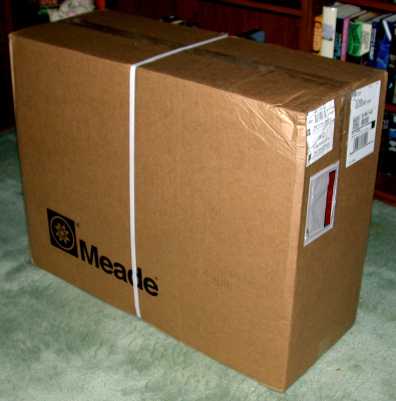
Due to various factors, including my trip to "Oracle Observatory", and clouds and rain, it took some time to open the box above and start using the ETX PE.
First, the unpacking. Since some users have asked about UHTC labeling, here is the one on the shipping box:
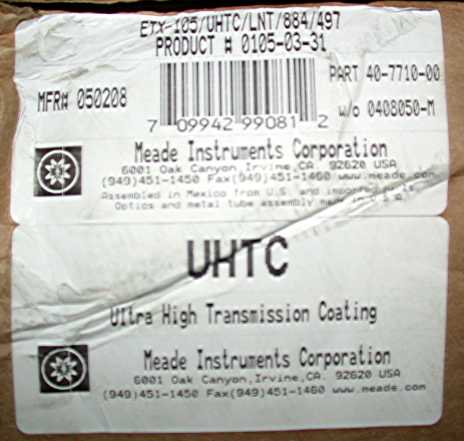
Here are the boxes that are inside the shipping box. Love that Premier Edition box! Reminds me of some of the images from the opening of "Star Trek Enterprise" on TV.
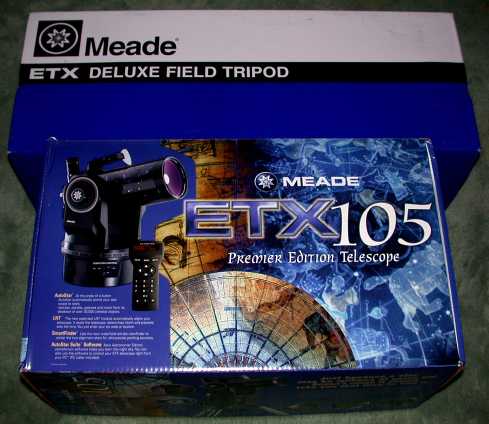
Inside the #884 tripod box. The well padded soft case is really nice and includes an adjustable shoulder strap. There are velcro straps inside the case to secure the tripod. A four page instruction manual is included.
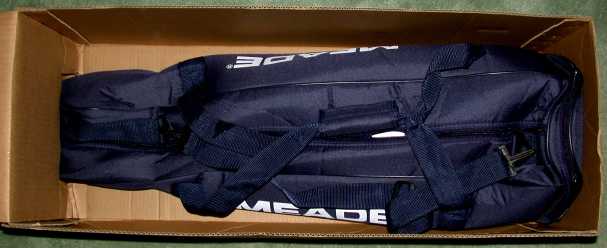
And here is the tripod set up in the Polar configuration (for latitude 25°). The tripod supports latitudes of 25° to 90°.
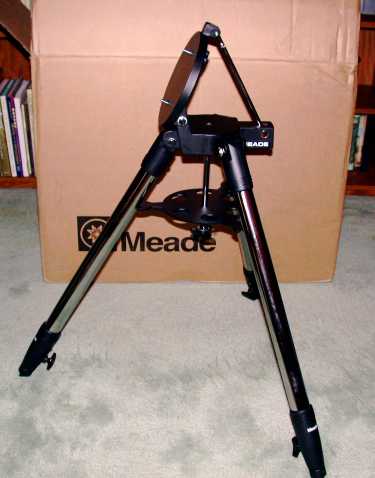
Inside the ETX box.
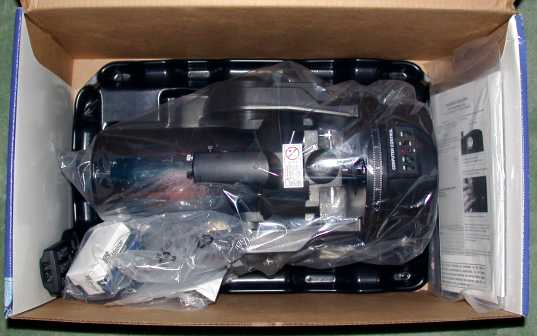
And what comes out of the ETX box. There is the ETX, Autostar #497, 26mm Series 4000 Super Plössl eyepiece, manuals, Autostar Suite Astronomer Edition (Windows only), #505 serial cable, DB9-RJ adapter for the #505 cable, two small hex keys, and a Meade ETX accessories catalog.
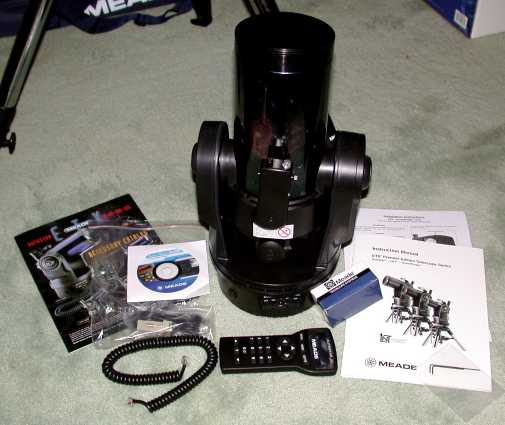
The UHTC label that appears on the bottom side of the OTA (Optical Tube Assembly):
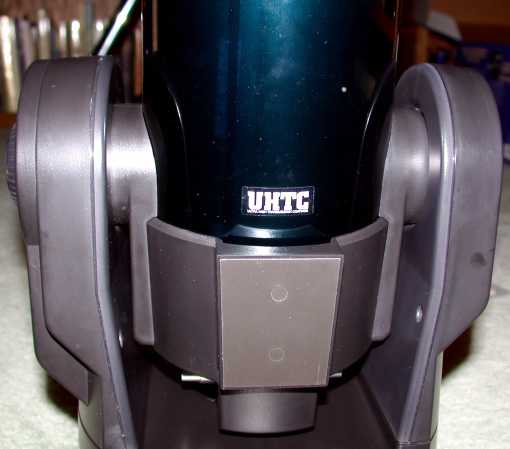
Like other new Premier Edition owners, I too had difficulties with the SmartFinder. There is a separate two page manual for the SmartFinder but it doesn't indicate the orientation of the lens when inserting it into the Level North Technology (LNT) module on the top of the ETX. There are two clues: the lens is convex and there is a small tab on the "tongue" which matches a cutout on the mounting slot on the LNT. I inserted the lens with the bulge to the front (which seemed logical) and that put the tab on the correct side to go into the LNT. But as you will see shortly, that was only half the solution. It took a lot of force to get the tongue to enter the slot. I was concerned with breaking the LNT off the ETX. The LNT did a lot of wiggling while I was attempting to install the SmartFinder lens. But I did manage to get it installed and that finished the initial set up of the ETX PE.
The ETX mounted correctly on the tripod (Alt/Az). Not that it matters for Alt/Az use but the photo on the cover of the manual is incorrect.
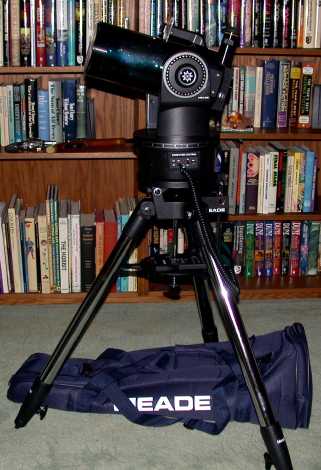
Here is the ETX-105 Premier Edition:
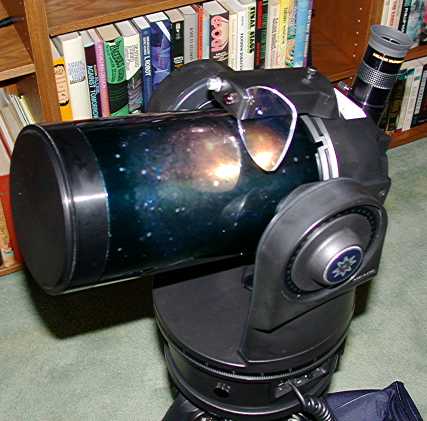
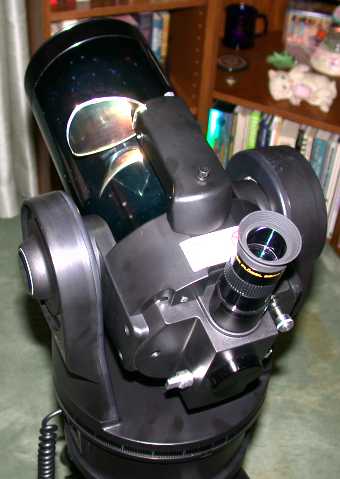
I then read the manual, just as I recommend that new owners do. This manual is much improved over earlier ETX manuals.
The Autostar had 3.3Ef installed. Set up for using the LNT is different than prior models. You still do the counterclockwise rotation to the first hard stop BUT you leave it there. Even leveling the OTA by hand is not required. You just lock both axes and turn on the ETX. It then goes through a leveling process and finds "North". The manual states that the ETX may not actually end up level and pointing North at the end of the process. In my short experience, it was close on both accounts. In the automatic alignment mode you don't enter the data and time either. The LNT module handles that. Once the leveling and north-ing is done, the rest of the alignment process is the same as with other models. Two stars are selected by the Autostar for alignment and you center them in the eyepiece.
OK, so now I know how to use the PE based upon reading the manual. Next step was to play with the telescope indoors to see how those steps actually work. That's when the oddities began.
I did a CALIBRATE MOTORS and TRAIN DRIVES. Then I entered my site location using my Zipcode. I then selected to do an Automatic Alignment. I accepted the stars (which seemed like odd ones for the date and time) as centered and did a GOTO Saturn. The Autostar told me it didn't rise until 1:49pm. Huh? The real local time was 6pm so I knew something was off. I checked the MODE display and discovered that my Zipcode had not been accepted by the Autostar. So I started over and selected the nearest city for my location.
 The leveling and north-ing takes 1 minute and 50 seconds, which is longer than it takes me to do the same process by hand. But then I can easily see Polaris from my current location. For many users, the automatic process will avoid HOME position set up errors. To see a video clip of the LNT in action, click the Level North Technology button on the right.
The leveling and north-ing takes 1 minute and 50 seconds, which is longer than it takes me to do the same process by hand. But then I can easily see Polaris from my current location. For many users, the automatic process will avoid HOME position set up errors. To see a video clip of the LNT in action, click the Level North Technology button on the right.
For this indoor test, with the nearest city selected, the Autostar picked Vega (wrong star for March at 6pm) and pointed nearly to the position of Polaris. First clue that something was still amiss. The second star was Altair and the ETX pointed higher in the "sky". Not good. I accepted both as centered and did a GOTO Saturn; got the same rise message as before. Checked the location in the MODE display and yep, my entry had not been accepted for some reason. OK, back to the site selection. I tried Zipcode this time. Entered it and pressed ENTER twice to confirm it. Went back to the MODE display and yep, there was my location longitude and latitude! Cool! It had been accepted. Started over again with the alignment.
Same problem! MODE display showed no location had been entered! So I set the site using the nearest city name. I powered off and back on, then checked the MODE display. No location entered! Tried to select again and got a SITE FULL error message. OK, time for a RESET to restore to factory defaults.
After the RESET, I entered my site by Zipcode. Went through the automatic alignment steps but the Autostar picked summer stars. Checked the MODE display again and the site location showed properly in the MODE display BUT the local time was 8 hours off. I reset the time from the Autostar menu and did another automatic alignment without powering off. This time all worked as expected. Yippee! I powered off and back on and repeated the automatic alignment. No problems. Time to go outside. Oops, spent so much time with the site problems that the clouds came in! Rats.
But the above demonstrates why it is important to work with a new telescope indoors before going outside in the dark.
OK, so it is now cloudy. At least I can align the SmartFinder to the ETX optics. Or so I thought.
The SmartFinder uses the main ETX power to illuminate its LED rather than having its own battery. (The LNT does have a battery to maintain its date/time info.) This was surprising but wasn't a drawback. I then discovered that I could not align the red dot. I was having the same problem as reported by others (see the article "ETX PE SmartFinder Tips"). The red dot would not move away from the far right side of the lens. Since this problem had been so frequently reported I decided to contact Meade. They requested that I bring it down, which I did.
What they discovered is that the lens tongue was inserted on the wrong side of the locking screw plate. That was preventing the adjustments from working. Here is a photo of what a properly inserted tongue looks like. If you look at the bottom of the LNT module and you should see the clear plastic tongue as shown:
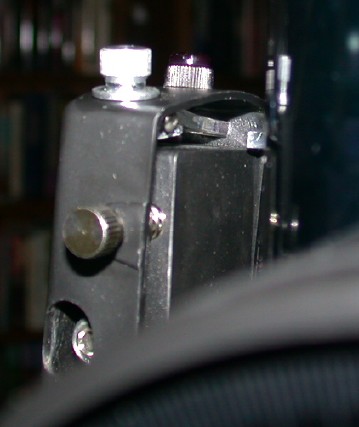
If the tongue is bent to the bottom side of the plate (which is just visible on the left in the photo above), slide it back out and re-insert it.
Meade also reseated the LNT module, which was loose.
Here is a view of the SmartFinder showing the red dot (overexposed). The sky appears red in this photo since it was very foggy outside.
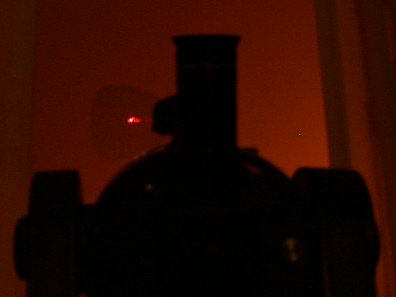
OK, so now I have a fully working ETX Premier Edition. And of course, it was clouding and raining! But finally the skies did clear up for one night and I was able to take the telescope outside.
I went through the automatic aligment but once again, I had to re-enter my site location and again, it didn't accept my zipcode. Odd. I also had to reset the clock using the Autostar. Odd. But when I did that, summer stars were selected for the alignment stars. Not good. Checked the MODE display; oops, there was no site location shown! RESET time!
Selected the nearest city. I then checked the MODE display and all was correct. Did an automatic alignment and the proper stars were selected. The ETX ended up pointing about 15 degrees east of the first star, Sirius. Centered it. The next star Capella was nearly right on. While looking at Capella I did a star test. Nice collimation. I then did a GOTO Saturn and the Autostar put it just slightly off from the center of the 26mm eyepiece field of view (FOV). Good. Did a GOTO Polaris and it was in pretty much the same location as Saturn had been in the eyepiece.
I then noticed that the SmartFinder LED was off. Apparently you are supposed to use it only during the alignment steps. It can be turned back on using the MODE display function. I did a GOTO Sirius and it was also just slightly off from the center of the FOV.
I then powered off and back on to confirm that my site location had "stuck". All was OK when I powered on. Again, Sirius was missed by about 15 degrees to the east. I checked the local time as shown in the MODE display; it was correct. GOTO Saturn was the same as before.
So, after some false starts with the SmartFinder, LNT, and the Autostar site selection, it now appears that I have a working ETX Premier Edition. It will be interesting to see what happens with the first alignment star after we switch to Daylight Saving Time. When doing the Automatic Alignment, you do not select a Daylight Saving setting so that must be a setting the Autostar and LNT know about. Maybe.
As to the SmartFinder itself, I was used to a "red dot" finderscope so I found the SmartFinder easy to use to center a bright star. The drawback to any red dot (or 1X magnification) finderscope is that there is no magnification nor extra light gathering power. So using the SmartFinder to find and center a faint object will be nearly impossible. But since you are supposed to use the Autostar to "find" those objects, this is less a drawback than it could otherwise be.
As I write this the weather is looking good for my second trip to Oracle Observatory on 2 April. I plan to take the ETX-105PE/UHTC with me on that trip for a full checkout under really dark skies. I will report back after that.
Stay tuned...
Return to the top of this page.
Go back to the ETX Home Page.